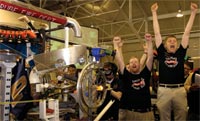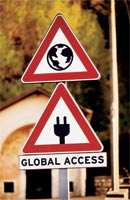Bits & Bytes
MICROSOFT WATCH
Enterprises are not rushing to upgrade to Windows XP SP2, according to a recent
study by AssetMetrix Research Labs. The study was based on data collected from
251 North American corporations with more than 136,000 PCs.
According to the study, only 24 percent of companies with Windows XP upgraded
to SP2, AssetMetrix says. Forty percent of companies using Windows XP are actively
avoiding the SP2 upgrade, while 7 percent have actively accepted the upgrade.
Fifty-two percent of companies surveyed have no policy about upgrading.
Companies choosing not to deploy SP2 will face a slew of potential problems,
including possible incompatibilities with future products such as Internet Explorer
7 or a support gap when Microsoft withdraws support for Windows XP Service Pack
1 in September 2006, according to AssetMetrix.
10 YEARS AGO
In the May 1995 issue of ADT, David Linthicum, systems manager at Mobil, discussed
in “Portability Pitfalls: Include Increased Cost, Potential Dissatisfaction,”
the importance of portable applications and the difficulty of building and deploying
them. The difficulty was due, in part, to performance, cost—paying more
than twice as much for portability than for a specific environment—and
unrealistic user expectations.
In “Hard Problems of Software Measurement,” Caper Jones, founder
and chairman of Software Productivity Research, said there were no known metrics
for quantifying the volume of data in a database, repository, data warehouse,
“or for that matter, data used by a corporation in any form. No metrics
exist for dealing with the costs of creating data, using data or removing unwanted
data.” Jones also noted metrics didn’t exist for measuring data
quality, even though the industry realizes poor data quality is a critical problem.
In his keynote speech at the Client/Server West Conference, Alan Kay, an Apple
Computer fellow, talked about the invention of continuously connected wireless
machines, which he called “intimate computers.” Said Kay: “Intimate
computers will eclipse even PCs by the year 2000.”
Kay was part of the team at the Xerox Palo Alto Research Center that foresaw
windowed user interfaces, object-oriented programming and networked desktop
PCs and workstations.
WEB WATCH
Forty years ago, Intel’s founder, Gordon Moore, predicted computer chip
performance would double about every year. That now-famous pronouncement was
first published in the April 19, 1965, issue of Electronics magazine, and now
Intel is willing to pay $10,000 for a mint copy of that issue. The company has
posted an ad on eBay’s Want It Now site (wantitnow.ebay.com).
Moore’s law has held up pretty well over the last four decades. If your
primo copy of Electronics magazine has done the same, now would be a good time
to cash in. The ad runs until June 12.
THINKPIECE
Do you have something you would like to say to enterprise application decision
makers? Do you have an opinion about the latest new-new thing from a well-known
software vendor? Application Development Trends is always interested in hearing
from end users and industry analysts who would like to contribute (for pay)
to our ThinkPiece column. Drop a brief note to [email protected]
describing your idea for the column and why you think you are the person to
write it.

LEFT/RIGHT BRAIN
The Purdue Society of Professional Engineers at Purdue University took top honors
in the annual National Rube Goldberg Machine Contest with a contraption that
took 125 steps to turn on a flashlight. Named after cartoonist Rube Goldberg,
college students from around the country competed to design a machine that uses
convoluted steps to accomplished simple tasks such as putting a stamp on an
envelope or screwing in a lightbulb. This year’s challenge, held in early
April, required the students to build a machine capable of replacing batteries
in a flashlight and turning it on using a minimum of 20 steps. The Purdue team
scored top honors for the third year in a row. |
NOTHING BUT NET
The use of cookies to track Web site activity is getting closer scrutiny by
consumers concerned about privacy and security, says Eric Peterson, an analyst
at JupiterResearch. “[Visitors] don’t want to be spied on.”
In its report, “Measuring Unique Visitors: Addressing the Dramatic Decline
in the Accuracy of Cookie-Based Measurement,” JupiterResearch says 58
percent of online users have deleted cookies. The report also found 39 percent
of online users probably are deleting cookies from their primary computers every
month. According to a recent consumer survey, 52 percent of online users indicate
a strong interest in stories regarding Internet privacy and security; 38 percent
of online users believe that cookies are invasion of their online privacy and
security; and 44 percent believe that deleting or blocking cookies will protect
them, JupiterResearch says.
Deleting cookies also affects how companies track visitors, Forrester’s
Chatham says. “Delete cookies again and again, it looks like two different
people visited [the site]. Stripping cookies inflates accounting and skews visits.”
BUY THE NUMBERS
A recent Yankee Group study breaks down the ongoing dust up between Windows
and Linux. In “The Linux-Windows 2005 TCO Comparison Survey,” most
U.S. business say there’s very little difference between the cost of maintaining
Windows and Linux.
Users rated security of Linux and Windows servers to be nearly equal, though
Microsoft continues to make “significant strides” in fixing its
security and patch management issues according to the Yankee Group. Windows
servers recover 30 percent faster from security attacks than Linux servers,
but the hourly cost of Windows downtime is three to four times higher than the
downtime of Linux servers. The research firm reasons the high cost of Windows
downtime is because there’s more crucial corporate data stored on Windows
servers.
The research firm found the quality, performance and reliability of Windows
servers equal to or better than Linux. Windows’ stronghold on customers
will make it difficult for Linux to displace it in these markets, but Linux
is gaining momentum as a complementary server in Windows networks. More than
50 percent of the companies surveyed said they expect to install Linux in parallel
with or in addition to existing Windows operating systems.
According to the study, most customers deploying Linux say they won’t
change the status of their installed NetWare and Unix systems. Some NetWare
and Unix users, however, will migrate away from those legacy operating systems.
Yankee Group surveyed 509 companies—SMBs and enterprises—covering
vertical markets, including healthcare, academia, financial services, legal,
media, retail and government.

OBVIOUS
The Department of Commerce recently finished a study, “Signposts in Cyberspace,”
on Internet traffic that Congress requested—seven years late. Congress
requested the $1 million federal study under a 1998 federal law, the Next Generation
Internet Research Act. The study centered on Web addresses and trademarks by
the National Research Council and was supposed to be finished within nine months.
Among its findings, the government agency concluded the Internet’s domain
name system is robust and capable of meeting the Web’s future needs; improving
Internet navigation will remain a profitable goal for commercial developers
and increasing the number of top-level domains available. It also suggested
minor technical improvements such as locating some of the Internet’s 13
key traffic-directing computers outside Los Angeles and Washington, D.C., to
secure the system from hackers and prevent outages from natural disasters. |
Other findings include:
- Both the DNS and the Internet navigation services will be significant
parts of the Internet for the future.
- The demand for geographically localized context information is likely
to grow rapidly.
- Basic research aimed at a better understanding of user behavior in a
variety of Internet navigation tasks using different methods and services is
highly desirable.
- Users have a high level of satisfaction with navigation aids and services.
- Navigation aids and services permit users across the globe convenient access and open an international audience to content and services, no matter where they’re located.
FACT MATTER
Enterprises will spend on average $500,000, or about $15.5 billion total, on compliance
this year, according to AMR Research. The total number will soar to $80 billion
over the next five years. Compliance
mandates companies are currently addressing...